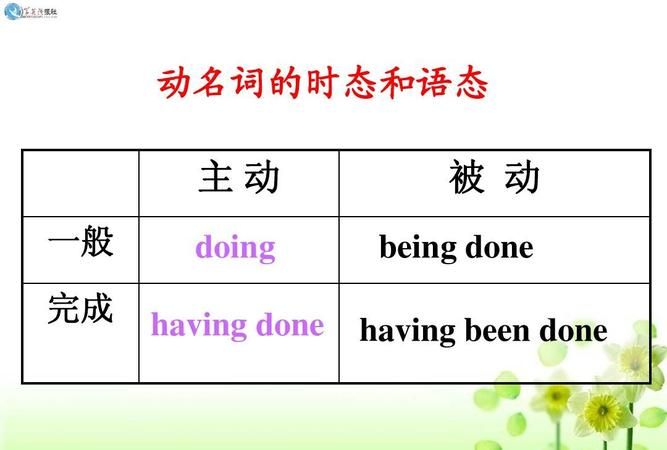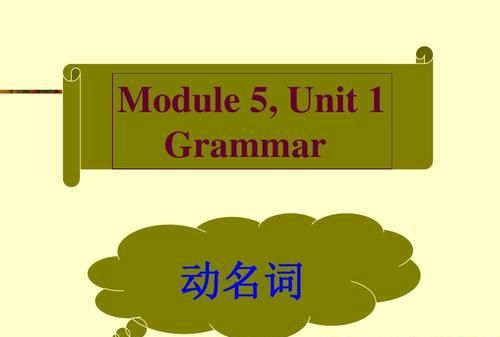本文目录
英语中什么是动名词?
如果一个动词加上了ing变成了名词,那么这个词称动名词。动名词常泛指,句法作用宾/表/定与主,时态/语态之形式,一般/完成/被动式。 动名词是一种兼有动词和名词特征的非限定动词。它可以支配宾语,也能被副词修饰。动名词有时态和语态的变化。
相关作用
动名词具有名词的性质,因此在句中可以作主语、表语、宾语、定语、补语、状语。
作主语
Working in these conditions is not a pleasure but a suffer. 在这种工作条件下工作不是一件愉快的事而是一件痛苦的事。
动名词作主语,谓语动词一般用三单形式
动名词作主语,在动词的基础上加Ing,使该动词或 动词短语,有名词的各种特征,可作名词灵活使用。如:
It is fun playing with children. 和孩子们一起玩真好。
There is no joking about such matters. 对这种事情不是开玩笑。
动名词作主语的几种类型
动名词可以在句子中充当名词所能充当的多种句子成分。在这里仅就动名词在句子中作主语的情况进行讨论。
动名词作主语有如下几种常见情况:
1. 直接位于句首做 主语。例如:
Swimming is a good sport in summer.
2. 用 it 作 形式主语,把动名词(真实主语)置于句尾作后置主语。
动名词做主语时,不太常用 it 作先行主语,多见于某些形容词及名词之后。例如:
It is no use telling him not to worry.
常见的能用于这种结构的形容词还有:better,wonderful,enjoyable,interesting,foolish,difficult,useless,senseless,worthwhile,等。
注意:important,essential,necessary 等形容词不能用于上述结构。
3. 用于“There be”结构中。例如:
There is no saying when he'll come.很难说他何时回来。
4. 用于布告形式的省略结构中。例如:
No smoking ( =No smoking is allowed (here) ). (禁止吸烟)
No parking. (禁止停车)
5. 动名词的复合结构作主语
当动名词有自己的逻辑主语时,常可以在前面加上一个名词或代词的所有格,构成动名词的复合结构(——这时,名词或代词的所有格做动名词的逻辑主语)。动名词的复合结构也可以在句中作主语。例如:
Their coming to help was a great encouragement to us.
6.例词
shopping fishing cycling这些都是很常见的动名词
动名词作主语与 动词不定式作主语的比较
动词不定式和动名词都可以用作主语。在意义上相近。但动名词多用来表示泛指或抽象动作,不定式多用来表示特指或具体动作。比较:
It is not good for you to smoke so much.
注意:
1) 在口语中,用动名词作主语位于句首的较不定式多见。
2) 在“It is no use...”,“It is no good...”,“It is fun...”,“It is a waste of time...”等句型中,通常用动名词作真实主语:
It is no use/good/a waste of time talking about that.
*It is no use/good/a waste of time to talk about that.
3) 在疑问句中,通常用动名词的复合结构,而不用不定式的复合结构作主语:
Does your saying that mean anything to him?
4) 在“There be”句型中,只能用动名词,而不能用不定式作主语:
There is no telling what will happen.
It is impossible to tell what will happen.
5) 当句子中的主语和表语都是非限定动词时,要遵循前后一致的原则,主语和表语在形式上要求统一:
Seeing is believing.
*To see is to believe.
作宾语
1.作动词的宾语
某些动词后出现非限定性动词时只能用动名词作宾语,不能用不定式。常见的此类动词有:
admit,appreciate,excuse,stand,advise,allow,permit,avoid,consider,enjoy,finish,give up,cannot help(can't help),imagine,include,keep,understand,keep on,mind,report,risk,miss,put off,delay,practise,resist,suggest,depend on,think about,set about,succeed in,worry about,burst out,insist on,feellike,be used to,get used to,devote…to…,look forward to,pay attention to,get down to,escape 等。如:
They went on walking and never stopped talking.
他们继续走,说个不停。
I found it pleasant walking along the seashore.
在海滩上走真是乐事。
Mark often attempts to escape being fined whenever he breaks traffic regulations.
每当马克违反交通规则时,他常常企图逃避罚款的处分。
有些动词之后既可接动词不定式,又可接动名词,可把这类动词分为三种类型:两种形式所表达的含义基本相同,可以互换。这类动词有:
attempt ,begin,cease,continue,intend,omit,start,cannot bear,decline,disdain,loathe,neglect,commence。例如:
They ceased talking/to talk.
他们停止说话。
Prices will continue to rise/rising.
物价将继续上扬。
What do you intend to do/doing next?
你下一步打算干什么?
宾语用不定式和动名词所表达的含义略有变化。用不定式作宾语时,表示特定的一次性的未来动作;用动名词则表示一般的行为,或者是目前正在进行的行为。也可以说,动名词表示泛指的动作,而不定式表示特指的动作。常这样用的动词有:
hate,like,love,prefer,dread等。例如:
Woula you like to go with me?
你想跟我一起走吗?
He preferred to do this rather than do that.
他宁愿做这件事,而不愿做那件事。
2.作介词的宾语
动词+介词+动名词
例如:The rain prevented us from completing the work.
下雨妨碍我们完成工作。
She complains of the book being too difficult.
她抱怨这本书太难。
形容词+介词+动名词
例如:I know who is responsible for breaking the window.
我知道窗户是谁打破的。
名词+介词+动名词
例如:There are many ways of doing it.
有许多方法可以做这件事。
We are thinking of making a new plan for the next term.
我们正考虑为下学期制定新的计划。
Shall we have a rest or get down to doing our work?
我们休息呢还是开始干活?
there be和it is也可变为动名词there being 和it being与介词连用。
例如:The car stooped because of there being no fuel in the tank.
因为油箱里没有油,所以汽车停了下来。
介词+动名词也可在句中作状语,表示时间、条件等。
例如:On leaving school,he went into business.
一离开学校,他就投身到商业中去了。
3.作形容词的宾语
The music is well worth listening to more than once. 这种曲子很值得多听几遍。
作表语
动名词作表语时句子主语常是表示无生命的事物的名词或what引导的名词性从句。表语动名词与主语通常是对等的关系,表示主语的内容,主语、表语可互换位置。如果句中的主语和表语同为动词时,要注意保持两个动词在形式上的一致。
例:
Your task is cleaning the windows.
你的任务就是擦窗户
我最痛恨的就是被别人嘲笑。(Being laughed at is what I hate most.)
作定语
动名词作定语往往表示被修饰词的某种用途。如:
a walking stick =a stick for walking=a stick which is used for walking
a washing machine=a machine for washing=a machine which is used for washing
a reading room=a room for reading=a room which is used for reading
a measuring tape=a tape for measuring=a tape which is used for measuring
sleeping pills=pills for sleeping=pills which is used for sleeping

英语里的动名词概念与用法
动名词是一种兼有动词和名词特征的非限定动词.它可以支配宾语,也能被副词修饰.动名词有时态和语态的变化.
解释:动词的ing形式如果是名词,这个词称动名词.
编辑本段一、动名词的作用
动名词具有名词的性质,因此在句中可以作主语、表语、宾语、定语等.
1.动名词由动词 + ing构成,否定形式为not doing,具有动词和名词的性质,在句中起名词作用,可作主语、宾语、表语和定语.
1)作主语.如:
Seeing is believing.
Laying eggs is the ant queen’s full-time job.
It is no use arguing with him.
注意:动名词和不定式都可以作主语,动名词作主语表示一般或抽象的多次性行为,不定式作主语往往表示具体的或一次性的动作.如:
Playing with fire is dangerous. (泛指玩火)
To play with fire will be dangerous. (指一具体动作)
但在It is no use/good, not any use/good, useless等后常用动名词间或用不定式.
2)作表语.如:
Her job is teaching.
3)作宾语.如:
He is fond of playing football.
I like swimming.
①admit,appreciate,avoid,consider,delay,dislike,enjoy,escape,excuse,face,feel,like,finish,forgive,give up,imagine,include,keep,mention,mind,miss,practise,put off,resist,risk,suggest,can’t help(情不自禁),can’t stand(无法忍受)等动词成词组后可以用动名词作宾语,但不能用不定式.
②forget,go on,mean,regret,remember,stop,try等动词或词组可带动名词或不定式作宾语,但意义上有区别.
Let’s go on studying Lesson 6. (让我们继续学第六课.说明前面已学了一部分.)
Let’s go on to study Lesson 6. (让我们接着学第六课.说明前面已学了第五课.)
I remember doing the exercise. (我记得做过练习.)
I must remember to do it. (我必须记着做这事.)
I tried not to go there. (我设法不去那里.)
I tried doing it again. (我试着又干了一次.)
Stop speaking. (不要讲话.)
He stopped to talk. (他停下来讲话.)
I mean to come early today. (我打算今天早些来.)
Missing the train means waiting for another hour.
(误了这趟火车意味着再等一个小时.)
③在allow,advise,forbid,permit等动词后直接跟动名词形式作宾语,如果后面有名词或代词作宾语,其后用动词不定式作宾语补足语.如:
We don’t allow smoking here.
We don’t allow students to smoke.
④动词need,require,want作“需要”解,其后必须用动名词的主动形式或不定式的被动形式作宾语表示事情需要做,这时,动名词的主动式表示被动意义.be worth后必须用动名词的主动形式来表示被动意义.如:
The window needs/requires/wants cleaning/to be cleaned.
Her method is worth trying.
⑤在短语devote to,look forward to,stick to,to be used to,object to,thank you for,excuse me for,be(kept) busy,have difficulty/trouble/problem(in),have a good/wonderful/hard time(in),there’s no use/good/need,feel/seem like/get down to等后的动词也必须用动名词形式,例如:
I look forward to hearing from you soon.
⑥在love,hate,prefer,like等动词后用动名词或不定式无多大区别.有时用动名词作宾语时,指一般情况,而跟不定式作宾语时指某一具体行为.
⑦start,begin,continue在书面语中多后接动名词,在口语中多后接不定式.
但start和begin在下列情况下一般跟不定式作宾语:当主语是物而不是人时;当start或begin以-ing形式出现时,当后面作宾语的动词表示感情、思想或意念时.如:
It started to snow. He is beginning to cook dinner. I began to understand what he meant.
⑧在should(would) like/love等后须用不定式.
4)作定语,例如:
He has a reading room.
2.动名词的复合结构
动名词的复合结构由物主代词或人称代词宾格、名词所有格或普通格加动名词构成.在句子开头必须用名词所有格或物主代词.如果动名词的复合结构作宾语,其逻辑主语是无生命的名词时,用普通格.如:
His coming made me very happy.
Mary’s crying annoyed him.
She didn’t mind his crying.
Is there any hope of Xiao Wang’s winning.?He insists on the plan being carried out.
3.动名词的时态和语态
动名词的时态分一般式和完成式两种,如果动名词的动作没有明确地表示出时间是与谓语词所表示的动作同时发生或在谓语动词所表示的动作以前发生,用动名词的一般式.如:
We are interested in playing chess.
His coming will be of great help to us.
如果动名词的动作发生在谓语动词所表示的动作之前,通常用动名词的完成时态.如:
I’m sorry for not having kept my promise.
在某些动词或词组后,常用动名词的一般形式,尽管其动作是在谓语所表示的动作之前发生的.如:Excuse me for coming late.
主语是动名词所表示的动作的对象时,动名词用被动语态.被动语态由“being + 过去分词”或“having been + 过去分词”构成.后一种一般很少使用,以免使句子显得累赘.如:
He likes being helped.
He was afraid of being left at home.
I don’t remember having ever been given a chance to do it.

英语中形容词可以修饰动名词吗
应该是不可以的,修饰名词的只有形容词,动名词和名词合在一起应该不是修饰关系而是共同组合成一个名词短语。

动名词可以当名词用吗
动名词兼有名词和动词两种意义
有的时候相当于名词,有时候比名词多一些用法,就是动名词后面可以接宾语

以上就是关于动名词可以在英语中作名词 ,英语中什么是动名词?的全部内容,以及动名词可以在英语中作名词吗 的相关内容,希望能够帮到您。

